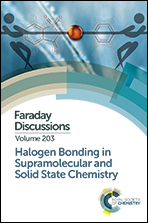Electron-transfer reactions of halogenated electrophiles: a different look into the nature of halogen bonding†
Abstract
The rates of oxidation of ferrocene derivatives by brominated molecules R-Br (CBr3CN, CBr4, CBr3NO2, CBr3COCBr3, CBr3CONH2, CBr3F, and CBr3H) were consistent with the predictions of the outer-sphere dissociative electron-transfer theory. The similar redox-reactions of the R-Br electrophiles with the typical halogen-bond acceptors tetramethyl-p-phenylenediamine (TMPD) or iodide were much faster than calculated using the same model. The fast redox-processes in these systems were related to the involvement of the transient halogen-bonded [R-Br, TMPD] or [R-Br, I−] complexes in which barriers for electron transfer were lowered by the strong electronic coupling of reactants. The Mulliken–Hush treatment of the spectral and structural characteristics of the [R-Br, TMPD] or [R-Br, I−] complexes corroborated the values of coupling elements, Hab, of 0.2–0.5 eV implied by the kinetic data. The Natural Bond Orbital analysis of these complexes indicated a noticeable donor/acceptor charge transfer, Δq, of 0.03–0.09 ē. The Hab and Δq values in the [R-Br, TMPD] and [R-Br, I−] complexes (which are similar to those in the traditional charge-transfer associates) indicate significant contribution of charge-transfer (weakly-covalent) interaction to halogen bonding. The decrease of the barrier for electron transfer between the halogen-bonded reactants demonstrated in the current work points out that halogen bonding should be taken into account in the mechanistic analysis of the reactions of halogenated species.
- This article is part of the themed collection: Halogen Bonding in Supramolecular and Solid State Chemistry


 Please wait while we load your content...
Please wait while we load your content...